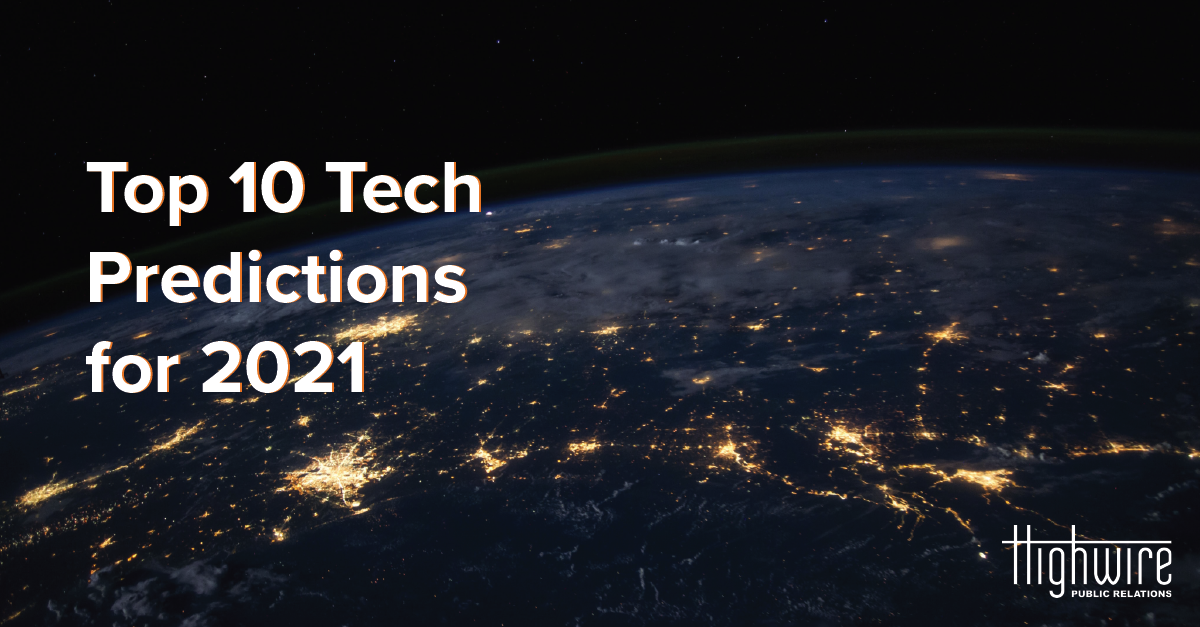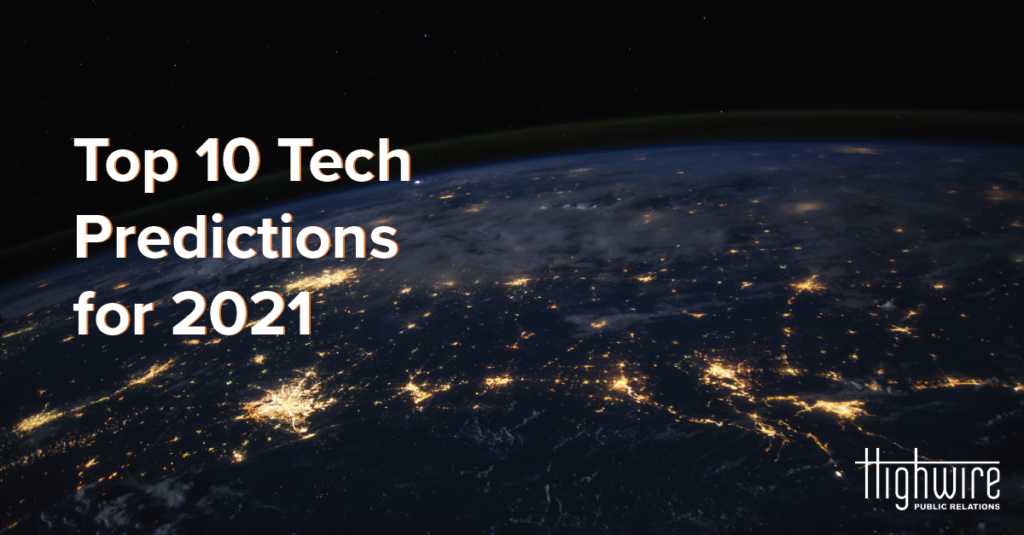

Still holding on? 2020 was jarring and fast/ slow in all the wrong ways. To help you navigate turns still ahead, we asked the Highwire team for macro-landscape 2021 predictions.
Here’s our technology forecast: business applications will drive innovation, ransomware attacks will threaten the White House, and remote monitoring tools will keep flooding the heart healthcare space. We’re betting that Instagram will oust Amazon for lifestyle shopping and fintechs will provoke bank branches to shutter.
Our deep relationships with the media and our clients give us perspective on how technology will reshape 2021. We hope these predictions — and our other blogs — will add fuel to your journey.
Enterprise
Alex Cardenas, Account Manager
Business, not the consumer will drive tech innovation in 2021
For decades consumer devices have been the drivers of tech innovation: Mac computers, Wifi, Napster, iPods, smartphones, Google maps, et.al.
Not since the introduction of the PC in 1980 has a business application been the primary tech driver. But with the rapid development of Artificial Intelligence business will take the lead because A.I. applications will be most impactful inside the business/manufacturing environment.
Autonomous vehicles and FedEx are the data centers of the future
Merriam-Webster’s dictionary definitions get updated every few years so it shouldn’t be surprising that we have new definitions of cloud. Hybrid cloud has reached a tipping point and the edge is now “on-prem:” forget about CAPEX-draining data centers, autonomous vehicles are now data centers on wheels and FedEx is one of the largest on-prem vendors in North America. This has huge implications for cloud, data and app development — and redefining hybrid strategies is the next major hurdle to competitive advantage.
Security
Ali Wilson, Account Executive
Cloud failures will skyrocket in 2021
COVID-19 has driven millions to work remotely–a change that happened almost literally overnight. Research indicates that organizations sped up transformation by as much as six years.
And it appears this change will, to a great extent, be permanent.
The problem is the change happened so quickly there was minimal attention given to preventative cybersecurity as security was forced from the centralized network. It was thrown to the wayside to appease evolving customer demands.
So, we expect to see an uptick in (successful) cloud attacks in 2021, as bad actors take advantage of poor data management practices, new technologies in the cloud, and hidden holes and vulnerabilities in cloud environments,
Cloud failures will hit an all-time high and no organization or industry will be left unscathed.
Christine Elswick, SVP
Cybersecurity will be a renewed priority for the new administration
President-Elect Biden was the second presidential hopeful to employ a CISO on the campaign trail, and the first VP to see a chief data scientist in the White house.
As he enters the White House in the top spot, we expect Biden will continue to prioritize cybersecurity at the federal level.
Amidst COVID-19, foreign adversaries remain quarantined with nothing but time on their hand and the largely remote, and disparate U.S. Government is their top target.
We anticipate a federal focus on data privacy and ransomware prevention among public sector entities.
Healthcare
Saige Smith, VP
More than 50% of those suffering from heart health conditions will adopt remote monitoring tools
The cardiology space is archaic with outdated methods to diagnose, treat and track heart health issues. That’s all going to transform in 2021. We expect that close to 50% of patients with some form of heart health issues will adopt a remote monitoring tool. Individuals suffering from heart health conditions, like atrial fibrillation, will conduct an electrocardiogram and report their findings to their cardiologists from home. This will dramatically curb costs associated with these conditions and ensure space is reserved for patients experiencing critical health issues. We think this pivot to remote care will also occur in other critical care areas like monitoring for diabetes and infertility.
Ali Nix, Senior Account Manager
As distrust in government to provide healthcare continues, patients will turn to their employers
A poll, which surveyed people from eight Northern California counties, was conducted in May and then September. In the spring, 58% considered the federal government’s response to the pandemic “very poor.” In the fall, that group increased another 5%. As people continue to distrust the government’s response to the pandemic, this will affect other areas of healthcare as well. We also predict patients will turn to their employers for guidance on best practices, where to get the vaccine (when it’s finally available), and more.
This will extend to mental health benefits and other ‘side effects’ of the ongoing COVID-19 pandemic, too. For example, multiple major benefits providers waived member cost-sharing for behavioral and mental health counseling services through the end of 2020. We think employers will increasingly be looking for ways they can support their employees beyond traditional support services and benefits.
Consumer
Courtney Geesey-Dorr, VP
Wearables will make a comeback and be bigger than ever
After a rather unexciting presence as recreational devices like FitBit, look for a new, more serious role for wearables to monitor critical matters like your immediate air quality, blood pressure and social distancing alerts.
Instagram will dominate style-centric product sales
Amazon may lead the online marketplace but look for Instagram to become the winner when it comes to items driven by style.
Instagram has two advantages: (1) it’s a visual medium that showcases stylish ads and (2) it’s recreational social media, so consumers spend hours on the platform being exposed to the brand messages.
Commerce
Kim Paone, GM
50% of bank branches will disappear by 2023
Due to the shelter in place mandates in many areas of the US, mobile banking has moved well beyond early adopters.
And there are no signs of traditional banking and money management coming back.
Instead, look for banks to rapidly partner with new fintechs to ensure safe and contactless offerings while they close expensive branches as fast as they can.
Consumers get supply chain savvy as E-commerce sales skyrocket
2020 brought e-commerce demand to a new level as consumers avoided in-store. Due to a strained supply chain and out of stock items, consumers began expecting more regular updates on the status of their purchases.
In 2021, consumers will expect a new level of transparency from all e-commerce brands.
It’s no longer enough to estimate a delivery date. They will want real-time updates on packing, shipping and the person who will visit their home for delivery. These insights will be key for the e-commerce brands that want to gain brand loyalty and trust from consumers.
